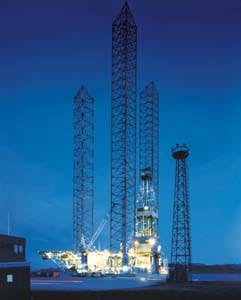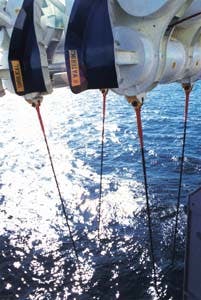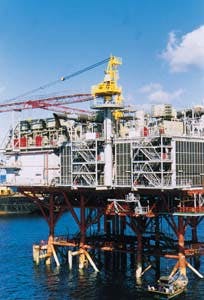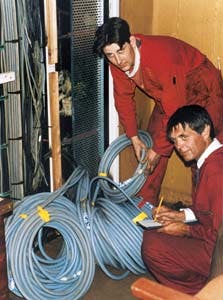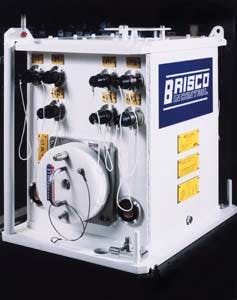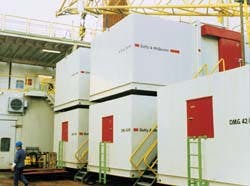UK Technology in SE Asia
Contractor trio transferring North Sea
operations and maintenance skills
Frank FrazerExpertise in managing offshore projects - based on experience gained in the North Sea - will be among the services marketed by Scottish-based participants at OSEA '96. Exhibitors will include two of the main offshore contractors with headquarters in Aberdeen: the Wood Group, and Atlantic Power & Gas, both of which have geared their activities in recent years to providing the multi-disciplinary range of skills required as North Sea oil operators began increasingly to outsource more of the day-to-day running of projects.
Editor, Scotland
According to Wood Group engineer and logistics director Bill Edgar, market research has shown that seven to 10 major contracts for operations and maintenance support could be out for bidding in the Asia-Pacific region over the next two to three years.
"As more operators circulate staff from the North Sea to Asia-Pacific operations, there will be a requirement for more of the disciplines we have been providing in the North Sea over the last five or six years," he said.
Wood's main involvement in the region at present follows its acquisition in 1994 of JP Kenny, the subsea engineering and pipeline specialist which has offices in Kuala Lumpur and Perth, Australia. This has provided a platform for work already being undertaken in Vietnam, Australia, Malaysia and Thailand.
Edgar said that the primary objective of the presence at OSEA would be to promote the services which the Wood Group engineering division could provide in the region. It was planned after the show to strengthen the company's presence by adding two Wood Group engineering staff to assist the existing management teams in the two centres with marketing.
As Scotland's largest indigenous energy services supplier, the group has progressively expanded its international activities as part of a strategy of positioning to retain world-class status as the North Sea oil and gas province matures. Its exports have risen steadily from #24 million in 1991 to #143 million last year, representing over a third of the total turnover of #372 million.
Edgar said that Latin America, particularly Venezuela, and the Asia-Pacific region were two key areas for international expansion based on offering services for project modification and maintenance as well as undertaking brownfield engineering contracts using experience acquired in this specialised area in the North Sea.
Sir Ian Wood, the group chairman and principal shareholder, recently claimed that evolution in contracting arrangements in the North Sea had enabled the engineering and logistics division to enhance its unique capability to provide operation and maintenance support services to mature oil and gas fields.
"We are increasingly able to demonstrate real differentiation in our approach to prolonging the life of the field," he said, "maximising hydrocarbon recovery and minimising decommissioning costs. Added to this is our growing strength in the development of marginal fields, based particularly on our capability in subsea engineering and the link back into existing process facilities."
Atlantic Power & Gas, one of the fast-growing new breed of UK contractors specialising in providing services outsourced by offshore operators, has already broken into the Asia-Pacific market with a contract to provide support for BHP's operations in Vietnam.
The deal stemmed from a relationship with BHP in the North Sea which was subsequently extended to cover services for the fields in Liverpool Bay. With other operational support provided for oilfields operated by Oryx and a recently-won contract for the Chevron/Conoco Britannia gasfield, APG has a workforce of around 1,000 engaged in UK activities. In the Asia-Pacific region its operations include a joint venture with APG Salamis in Brunei which should provide additional scope for expansion in the region.
AOC International, another prominent contractor offering a broad range of integrated services to UK operators, is also involved in operations in Brunei after picking up a two-year offshore construction and maintenance contract awarded by Shell earlier this year to apply contracting and management techniques which have proved highly cost-effective in improving the efficiency of North Sea operations.
Although AOC's parent company OGC International said the financial implications of this deal were among factors leading to poor profits in the first half of 1996, the terms are being renegotiated in an attempt to restore profitability.
The company has an Australian subsidiary which has notched up considerable success in adding new customers, including the Ampolex Wandoo alliance which recently awarded it a #3.2 million contract for hook-up and commissioning for a project off Western Australia. Responsibility included auditing fabrication work and performing onshore commissioning of topsides in Singapore prior to sailaway.
The project, involving more than 90 offshore personnel during the final hook-up stage, is due for completion by the end of this year. This award followed an earlier #15.5 million contract from Western Australia Petroleum for maintenance and modifications on its facilities which further helped consolidate AOC's position as a leader in the Australian oil and gas market.
Drawing on experience in building up a business with about 3,000 employees engaged in North Sea operations, AOC will be promoting its services in project management, training and technology transfer to help operators in Asia-Pacific countries develop their own indigenous workforces.
Dundee/Angus group to promote
engineering expertise at OSEA
Santa Fe Drilling's Galaxy I was berthed at Dundee last year for a routine IRM service. (Left) Subsea tethers attached to the underside of a support buoy for Shell's Teal, Teal South and Guillemot development feature reinforced cable co-engineered by TTI.One of the most significant players at OSEA '96 will be the party led by the Dundee & Angus Oil Venture Group (DOVG) - an industry group formed more than 11 years ago which has become a role model for public/private sector partnerships throughout Scotland.
The Group maintains a full-time development manager, Ed Smith, whose role is to work with Group members in pursuing a twin-track strategy of publicising the many advantages of Dundee and Angus as a base of offshore operations, and also helping local companies exploit new business opportunities on the international stage. Four companies will be exhibiting alongside DOVG at OSEA: Kolfor Plant, Pacson, Tension Technology, and NICC.
Dundee's credentials as a base for offshore contracting work have been firmly established by a succession of rigs which have dominated the Port's skyline in recent months.
Last year Santa Fe Drilling's heavy duty jackup Galaxy I was the first of her kind to visit Dundee, and she has been followed this year by three of her sister rigs, including the Monitor and the Magellan. Most recently, the Monarch became a temporary landmark in Dundee alongside the Prince Charles Wharf during July while modifications and routine repair/maintenance works were carried out.
At around 10,000 tonnes each, these are among the largest jack-ups in the world, and they have certainly made an impression on Dundee where their 150-metre high legs challenge the city's permanent landmark - the Law Hill - for dominance of the skyline.
"Tayside is now ranked second in Scotland in importance to Grampian as a centre for technological innovation in the international oil industry," says Ed Smith, and contains several companies which have established world-leading positions in specialist areas.
"With skills and technology honed in the demanding environment of the North Sea, our members are rapidly expanding into other areas worldwide. The Dundee and Angus companies exhibiting with us at OSEA typify this development."
Kolfor Plant, owned and run by the flamboyant John Beaton, is one Dundee-based company that already operates extensively in South-East Asia, hiring out plant and equipment both directly and through European-based operators. Beaton, who is also chairman of DOVG, intends to set up a permanent base for Kolfor Plant in the region in the near future, comprising support facilities and a wide range of equipment permanently on station there. A recent contract is for #250,000 worth of kit to a British company operating in Brunei.
Kolfor recorded a 36.7% increase in turnover in the year to May 31, and invested heavily both in new equipment and in the purchase of shot-blast equipment manufacturer Russell International to form a new division, Kolfor Russell.
Another presence on the DOVG stand at OSEA, Carnoustie-based Pacson, will be showing its range of "monoblok" compact pipeline valves for the oil and petrochemical industries. The valves are designed to offer maximum flexibility in size, shape and end connections whether of the single, double block-and-bleed or multi-valve manifold type.
"These valves are designed for the most arduous operating environments both on the surface and subsea," said technical sales director Keith Crawford. "Since we began to manufacture and market these into the North Sea market seven years ago, we have penetrated international markets as well, including South-East Asia, and have enjoyed a steady growth in demand for our products in the past three years."
Tension Technology International (TTI) of Arbroath, also exhibiting at OSEA, has been contracted by Linear Composites to provide design, development and engineering services for a major project in Shell North Sea's Teal/Guillemot development.
Linear Composites' 200 tonne break-load Parafil polyester-reinforced cable is being used for the subsea tethers holding the development's riser and support buoys. TTI developed novel termination techniques incorporating polymeric components to minimise friction and inertia and maximise fatigue resistance. Additional work included tension-tension fatigue, creep, vortex-induced vibration analysis and estimates of the effects of localised bending at the termination. Prototypes were developed jointly by Linear Composites and TTI using the latter's in-house computer models.
TTI's pre-eminence in this area has been demonstrated by a series of new contracts in recent months, including its appointment as consultant to a joint industry project to provide guidance on the use of fibre ropes for floating production system moorings.
TTI is also part-way through a key research project looking at ways of limiting heat build-up in moorings subjected to repeated loading. Having won two Scottish Office SMART awards to support the project, TTI is studying the effects of incorporating high conductivity materials and additives into the rope structure, with very promising results.
Serck Baker awarded further
Bach Ho water injection package
Bach Ho's water injection platform where the Stage II WI module is currently being installed and commisisoned.Stage 3 of Vietsovpetro's Bach Ho II water injection scheme has been awarded to Serck Baker and its joint venture partner, Sembawang Engineering. The contract is worth over $15 million to the two companies, which also supplied the Stage 2 systems.
Process equipment for the latest phase is being built at Serck Baker's premises in Gloucester. The new 600 tonne water injection module, to be fabricated in Sembawang's Singapore yard, will incorporate coarse and media filters, a vacuum deaerator, chemical injection equipment and lift booster and injection pumps. All this will help provide a further 10,000tonnes/day of injection water, controlled from a DCS system located in the power generation module.
Two years ago, the two companies won the $60 million turnkey contract for the Bach Ho II integrated water injection platform, which included supplying three 70,000 b/d water injection modules and one power generation module. But the fourth and current building block in the injection scheme still had to be tendered for competitively, due to the Vietnames authorities' insistence on open bidding for contracts where possible.
The first module is already commissioned and injecting water into the reservoir from the platform: the next two should be operational shortly. Following functional tests at Sembawang, the modules were shipped to Vietnam where Vietsovpetro loaded them onto its crane barge for installation on the platform under the supervision of the two joint venture companies.
The modules are being installed on a module support frame: this and the jacket were both designed by Sembawang and fabricated in Vung Tau, Vietnam. Lifting restrictions on the crane barge dictated the modules' low weight. Weight was trimmed partly through incorporation of FRP pipework around the modules and the support frame.
For this project, Serck Baker has formed an integrated team with Sembawang that works closely with the client and Vietsovpetro. So far, delivery schedules have been attained.
All four water injection modules at 13 x 19 x 16 metres are similarly configured. The power generation module comprises three 4MW turbines. Although the technology is not particularly novel, the modules have been engineered to international standards with certification by DnV, with a 20-year design life.
The Vietnamese did not want to repeat past mistakes where high maintenance costs and extended periods of downtime occurred.
For Bach Ho II, the Vietnamese have also embraced the concept of third party certification. The water injection platform has been certified by DnV and Lloyds in Singapore and London: Serck Baker's packages passed with a clean bill of health.
The Stage 2-3 contract is one of Serck Baker's biggest from the offshore industry. There is a prospect of an assignment for another Vietnamese development which would have a relatively small water injection requirement.
Apart from Bach Ho and a produced water package for the Xijiang Field off China, the Far East has been a quiet market for Serck Baker. But it is interested in forming alliances with other Far East yards to chaes projects particularly off Malaysia and Indonesia. It is also bidding for work on a new FPSO for the Norwegian sector under construction at a Far East yard.
In the UK North Sea, Serck Baker is working with sister company Howmar International on the process separation and produced water treatment package for Shell's Curlew FPSO. Scope includes Oilspin AV liquid hydrocyclones, which Serck Baker is supplying.
Also on the books at Gloucester is a sulphate removal membrane separation package for BP's ETAP Field complex. The order is for a 20,300 b/d membrane separation system, media and cartridge filters treating wash water.
Wandoo metering project marks
NW Shelf debut for Jordan Kent
Jordan Kent's package comprised two eight-in. turbine meter streams, a master meter stream and an Entelec multi-stream flow computer system. Work was engineered in close co-operation with the main project contractor, Wandoo Alliance. This job was secured following direct negotiations in Australia, although Jordan Kent's parent company, Alderley Holdings, has its own network of agents nearby in Malaysia, Thailand and India.
Aside from Jordan Kent, there are three companies within Alderley, often working together on the same projects. Of these all but Entelec, which is based in Pickering, are housed at the same complex in Wickwar.
Jordan Kent is the group's main supplier to the offshore sector. Its products range from gas and liquid metering systems to skid-mounted uni- or bi-directional meter provers to flow measurement computer-control systems. Two years ago it supplied condensate and gas metering systems for a project off Malaysia; it also supplied a fiscal oil metering system for BP's Harding production jack-up to fabricator Hyundai in Korea.
Due to the high viscosity of Harding's crude, mass flow meters were ordered in combination with a small volume prover to supply the high accuracy measurements required. The delivered package incorporates two main skids comprising three three-in. and seven six-in. flowlines.
Proving is being achieved by means of a small volume prover, with control fully computerised. The coriolis instruments were proven during factory flow tests with water to give a similar performance to traditional turbine meters.
Jordan Kent's most recent North Sea-related deliveries have included five metering systems for the CATS gas gathering expansion project at Teesside, UK, due to add 600 mcf/d to the Seal Sands processing facility when the first phase is completed next year. Two of the systems will measure gas through three 16-in. orifice streams rated at ANSI 600 and 900. The other three, all mounted on one skid base, will measure propane, butane and natural gas.
Another contract - Jordan Kent's fourth for a floater in the past three years - came from SLP Engineering for the complete metering computer system that will control three oil metering streams on Conoco's MacCulloch development, as well as a bi-directional prover and a comprehensive sampling and density system.
Jordan Kent will be the main exhibitor at Alderley Holdings' stand at OSEA. But sister company Alderley Materials will also feature Contratherm C50, a new fire protection material developed with assistance from BP Chemicals. This is a cold curing phenolic syntactic foam suited, for instance, to open decks of FPSOs in hostile environments (including BP's Foinaven).
C50 is used with conventional epoxy intumescent fire protection materials for separators, slug catchers and pipework to provide thermal insulation that works in hydrocarbon fires, protecting the intumescent foam from thermal degradation. It also generates a robust, crack-free coating offering corrosion protection.
Mozley hydrocyclones to clean West of Shetland solids
The aim of the system was to clean the intermittent production solids discharge associated with sand jetting operations. Due to the highly abrasive nature of the solids, high quality ceramic was used in construction of the hydrocylones.
Mozley's oil-sand cleaning, or sandwashing, technique was developed with Chevron UK for the Alba Field project. The technique involves mass transfer of oil from the surfaces of contaminated solids into a liquid phase using the shearing forces generated within a hydrocylone.
Free oil leaves the hydrocyclone in the overflow stream as an oily water product while the clean solids discharge from the underflow. This is achieved by recirculating the solids, slurried with water, through a pumped loop so that the oil is scrubbed from the solids by a process of attrition.
Using this concept, residual oil on the cleaned solids is typically better than 10 grams of oil per kilogram of dry solids (approximately 1% weight/volume). Advantages of the system include high throughput/unit weight; compactness; low energy input; low capex; flexible, modular design.
Mozley, based in Redruth, UK, has a network of agents throughout Australia.
Mita finds willing market out East
for composite cable housings
Fibagrid GRP grid flooring system.Glass fibre-reinforced plastics (GRP) have never had an image problem in the US or South-East Asia. The low-maintenance, rust-free qualities of this composite material are ideally suited to offshore installations in regions of high humidity.
North Sea operators, however, remain by and large suspicious of composites, which explains why much of Mita Powercomponents' turnover is exported, including to the Far and Middle East. Mita, based in Bodelwyddan, North Wales, is a specialist manufacturer of GRP cable management systems, including cable trays, ladders and racks, as well as grid flooring systems. It began manufacturing in this material in 1990, attracting immediate interest from Shell UK Expro which was evaluating advanced construction materials in the light of the Piper Alpha fire.
Mita's systems came successfully through Shell's trial installation. However, other operators have preferred to stick with stainless steel, even though the benefits of GRP in cable management are patently obvious, according to Mita Powercomponents divisional director Andrew Stockton:
"GRP is extremely corrosion resistant; it is suitable with seawater, and it is also 30% lighter in weight than steel." Unlike stainless steel, it can also be installed for retrofits offshore with a cold work permit, leading to no production downtime. By contrast, with steel systems a temporary shutdown is mandatory because of sparks caused by welding and cutting. A further benefit with GRP systems is that there is no earthing to check and the system therefore becomes virtually maintenance-free.
Installation is also easier, claims Stockton: "Fewer people are required to handle it, it is easy to drill and cut by hand and does not need de-burring when cut - whereas steel necessitates removal of sharp edges caused by the cutting process."
Offshore South-East Asia, GRP usage has been commonplace for the past decade. Mita's exports to this market took off in 1992: as interest continued to grow, it set up offices in Singapore and last year in Kuala Lumpur, in response to enquiries from Petronas Carigali to which Mita is an approved supplier.
One project in Indonesia involving two offshore fields has generated Mita #200,000 of business over the past three years. Other clients in the region include Shell and JGC, for offshore installations and refineries, and India's ONGC.
"For a typical offshore platform," says Stockton, "we would produce some 5-800 metres of material encompassing cable ladders for power cabling; cable trays for instrumentation; and GRP support channels to form supporting structures. Additionally, each installation generally uses 1-3,000 metres of glass-fibre grid flooring access systems."
Mita's South-East Asia export manager is employed at the Kuala Lumpur office. "He would make initial contact with the offshore operator to obtain details of the project and also with the contractor responsible for the design. We then have plenty of involvement with the construction yard at the design and tender stage. We also have a UK-based person approved to go offshore for advice on installation."
Fibagrid
Mita's newest product for the offshore sector is Fibagrid, a patented access/grid flooring system. Like the cable management products, Fibagrid's GRP material is produced by the pultrusion process. Continuous glass fibres and reinforcements are drawn through special dies where they are impregnated with resin and shaped to form the required section before they solidify.
The standard resin system used is isopthalic polyester flame retardant to BS476 part 7 class 2. Physical properties of the resultant material are retained even under continuous operating temperatures of -120 to +140!C.
Fibagrid gratings are made with load-bearing and transverse bars, all pultruded. `I' sections are produced as load-bearing bars which have a slip-resistant surface, if required, achieved by use of bonded grit after the pultrusion process. The transverse bars are designed to mechanically lock into position at each load-bearing bar prior to being bonded by Mita's resin process.
Unlike conventional purely bonded gratings, this locked system allows the transverse bars and floor panels to be cut and fabricated without loss of strength and rigidity, leading to longer service life, even in extremely rigorous daily use. Fibagrid gratings come in standard panels three metres long by nominally a metre wide.
According to Stockton, Mita has spent many thousands of pounds in fire testing its products at the Warrington Fire Research Centre in England, to disprove rival steel manufacturers' claims that GRP disintegrates in extreme fire conditions. Mita products gained certification for flame spread, toxicity, smoke and fire survival up to 1,000!C, depending on the resin system used.
Baker Hughes builds on anti-biofouling expertise
Sea Cell as supplied to a platform offshore India.Anti-biofouling equipment will be a key feature of Baker Hughes Processing Systems' (BHPS) stand at OSEA. The Rugby-based group strengthened its expertise in this field last year through acquiring BFCC, a technology transfer company from the University of Sheffield.
BFCC had developed a marine growth protection technique for ships and platforms based on copper chlorine technology. BHPS itself was the proprietor of the Metrol Sea Cell electrochlorination system. As a result of the acquisition of the copper/chlorine patents and the relevant marine biology expertise, BHPS can provide suitable anti-biofouling solutions for most situations without being limited by technology.
Through the combination of the two techniques, BHPS now claims to offer simultaneous electrolytic production of copper and chlorine at concentrations up to ten times lower than other anti-biofouling systems.
In the Asia-Pacific region, BHPS has delivered equipment packages to offshore installations in India, Malaysia and Vietnam. Worldwide, equipment has been installed to treat both micro and macrofouling in seawater lift pumps, firewater systems and process water systems, including water injection and produced water.
Through the installation of a low concentration copper adding system to BHPS specifications, the benefits of the patented copper/chlorine technology can be simulated, allowing the capacity of existing liquid chlorine dosing or electrochlorination equipment to be reduced by up to 75% of dosing capacity.
Units are supplied in modular form and mounted on skids, comprising electrolysis cells and an electrical control panel designed to meet any special requirement for safe or hazardous areas. According to BHPS' anti-biofouling product manager, Brent Knox-Holmes, the Sea Cell is the only cell of its type certified for use in hazardous areas without an enclosure. Competing products supplied with enclosures need to be ventilated, otherwise hydrogen and sodium hypochlorite leaks could occur.
BHPS currently is delivering chlorinator packages to North Sea projects such as ETAP, MacCulloch and Schiehallion.
Other products on the BHPS stand will include the recently acquired Vortoil hydrocyclones - Vortoil operates its own office in Singapore; Metrol sea-injection and Wemco flotation systems.
(Top left) Offshore cabin modules from Duffy & McGovern. (above) Peto Service cables. (left) Wellcon subsea control system from Brisco, as supplied to BP's UK North Sea Newsham development.
Great Yarmouth group displays its wares at OSEA '96
Backers in the partnership are the Borough Council, the Port Authority, the Chamber of Commerce, the Port Users' Association and Norfolk County Council. Around 40 private companies are associate members.
The town acts as the service centre for the southern UK North Sea gas basin, with over 400 oil and gas sector companies locally employing close to 5,000 people.
At OSEA '96, GYMI is helping five companies promote their goods and services: BCD Group, Brisco Engineering, Duffy & McGovern, Maritech Consultants and Sonar Equipment Services. BCD in fact has three subsidiary companies that will be exhibiting.
BCD Cables is a stockist and supplier of offshore and marine cables as well as cable accessories. Its standard stock includes a full range of unarmoured, armoured, fire-retardant, fire-resistant, power, control and instrumentation cables. Recent UK North Sea projects supplied include the converted FPSO Uisge Gorm for Amerada Hess's Fife Field, and Texaco's new Erskine development. BCD is keen to meet potential clients and agents at OSEA '96.
The Eastern Switchgear subsidiary makes and installs tailor-made electrical control systems and associated equipment, and has solid experience of hazardous area applications. It can handle total projects from design and panel manufacture through to on-site installation.
Another electrical engineering company belonging to the BCD Group is Peto Services, which undertakes project support from pre/post purchase surveys to purchase and repair procurement specifications. It can also handle design review to system development. Recent projects include failure surveys within production facilities (Africa), and panel manufacture and installation on FPSOs for Cegelec, ABB and Bluewater.
One of the better known companies internationally on GYMI's stand is Brisco Engineering, which has developed an electro-hydraulic subsea wellhead control system named Wellcon. Having established this product in the North Sea, Brisco has now established a regional office in Malaysia to develop the market for subsea installations in South-East Asia.
Wellcon combines contemporary communications control and executive functions into a compact, lightweight subsea control module (SCM). This is usually installed on the subsea well completion manifold or templates, with diver intervention or through ROVs, depending on water depth. Modules are connected to the surface mounted hydraulic power generating system, electrical power supply and communications systems by composite electro-hydraulic umbilicals.
The SCM contains proven electro-hydraulic interface relays in a modular arrangement to control up to 24 hydraulic functions and 16 remote sensor inputs, such as pressure, temperature and flow. These are all connected to the subsea electronic module (SEM) housed in the SCM.
The SEM employs advanced multiplexed communications and microprocessor technology to provide a secure, fast multi-drop telemetry system and flexible I/O capability. It also includes a power supply module, I/O and communications modules all sealed within a one-atmosphere environment.
Communications functioning with a data rate of 4,800/9,600 baud can operate over 50 km distances using communications superimposed on power, thereby reducing the number of electrical conductors required in the umbilical. Up to 25 multi-drop SCMs can be supported.
One of Brisco's recent successes was the contract for the major subsea control system components for Amerada Hess' current Durward/Dauntless development. It has also supplied BP's Newsham and Conoco's MacCulloch projects plus a control system for Conoco's Banff extended well test.
Duffy & McGovern has supplied A60 fire rated accommodation units to the offshore industry for 25 years. These and its AO cabins cover all offshore requirements: four, six or eight-man sleepers, toilet blocks, MWD and LWD cabins, offices, galley and recreation rooms, all tested for North Sea conditions. Cabins can be supplied at short notice anywhere in the world: some have been supplied to bolster accommodation on Bass Strait platforms off Australia.
The company's cabins can be modified to suit the varying hostile conditions found offshore. Currently the company is working on a design for a multi-purpose, universal unit to meet numerous needs, for safe or hazardous areas in all climates anywhere in the world where access is difficult. The design will facilitate assembly of units into interlinked complexes, if required.
Maritech Consultants provides geophysical and survey consultancy services relating to rig positioning, platform installation, rig-site investigations, pipeline inspections, pre-route pipeline surveys. It also offers project management, survey data analysis and training, sometimes on the spot: for instance, Maritech trainers recently gave instruction on geophysical data analysis in Mombasa.
Local representation has been established in Indonesia this year to support South-East Asian activities, and similar arrangements are being investigated for other global regions.
Finally, Sonar Equipment Services is a supplier of acoustic and geophysical survey equipment including sidescan sonar, subbottom profilers, boomer systems, hydrophones, magnetometers and winches. It also manufactures sonar winches and tow retentions. A recent development is a multiplexed subbottom profiler for use on ROVs, particularly for pipeline inspection duty. Equipment can be bought or hired from the company's Great Yarmouth base.
Copyright 1996 Offshore. All Rights Reserved.

